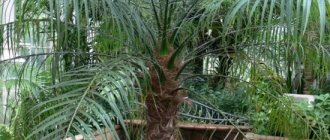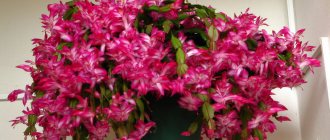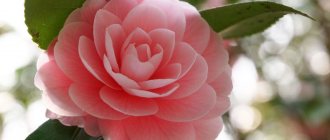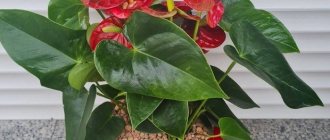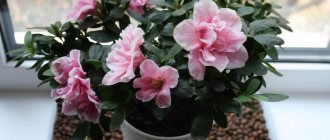Main types of culture
There are several varieties of indoor Pilea flowers, among which the most popular are the following:
- Cadieux variety. An adult plant reaches a height of 40 cm. The leaves have an oval shape and a pointed tip. You can recognize a representative by the characteristic color of the leaves (green with silver-green spots).
- Small-leaved variety. One of the shortest plants in this family. An adult plant has a thick stem, the shoots of which quickly take root when in contact with the ground. The leaves are light green, round in shape.
- The plant is a tender pilea, the stem of which spreads along the ground as the plant grows.
Very interesting are the subspecies, which are characterized by coin-shaped leaves. Despite the differences in structure, these crops have virtually no special care requirements at home (watering, lighting, temperature and humidity levels).
3.Varieties:
3.1. Pilea Cadiere or Peperomyoid - Pilea cadierei
Fast growing herbaceous, perennial, evergreen plants that naturally grow in tropical forests. The plant is compact - even adult specimens reach a height of only 25 - 30 cm. The leaves are oblong - oval, arranged in opposite pairs. The main background of the leaf blade is dark green, with oblong silvery spots on it. The flowers are collected in small umbrellas and can appear at any time of the year, but often go unnoticed. When grown indoors, flowering rarely occurs.
↑ Up,
3.2.Pilea microphylla
Perennial evergreen plants native to South America can reach a height of 15 to 30 cm. With age, they form a wide mat that densely covers the ground. Pilea smallifolia has abundant branching at the base, thin shoots. The leaves are very small, oblong-oval, glossy, and can be painted in all shades of green. Leaf blades are entire. The flowers are greenish, very small, axillary, densely covering the plant stems. When grown indoors, flowering rarely occurs.
↑ Up,
Room temperature
This culture belongs to heat-loving plants. The most optimal air temperature range is between 20-25 degrees. For some subspecies, experts recommend lowering the air temperature to 18 degrees in the winter months (due to the characteristics of metabolism).
It is important to protect the plant from drafts, but summer air baths are very useful for active growth.
Botanical description
More than 400 species of the genus Pilea (lat. Pilea) are found in the nettle family (Urticaceae). There are both annual and perennial species. Plants are herbaceous or subshrubs. They grow in tropical zones all over the Earth except Australia. These are hardy ornamental foliage plants that grow up to 40 cm in height. They grow well in warm flower beds, winter gardens and shop windows. Pilea Cadieu grows very quickly, therefore it is valued and used in arranging plant compositions. The flowers of the plants are unisexual and small, often growing in racemose axillary inflorescences. Pilea spreads its fruits in a very unusual way. This is similar to catapulting - the sterile stamens grow greatly by the time of fruiting and only slightly support the fruit that hangs over them. When the fruit ripens, the connection between plant and fruit becomes weak. Staminodes (sterile stamens) straighten and throw the fruit up to 100 meters away!
Optimal watering of the plant
This plant is known for its love for abundant watering. Rules for watering a flower:
- In the summer-autumn season, it is necessary to maintain constant soil moisture in the pot.
- On the hottest days, the frequency of watering is 1 time in 2-3 days (excess moisture, in turn, will quickly lead to rotting of the roots and death of the plant).
- All representatives of this family prefer high indoor humidity. In this case, the leaves should not be sprayed. The surface of most leaves has a velvety structure, drops of water on which look very untidy (but do not lead to the development of diseases).
To maintain an optimal level of humidity, you can place a flower pot in a container of water, inside which a layer of gravel or pebbles is poured. The stones prevent direct contact of the soil and the root system of the plant with moisture, and, accordingly, do not allow the roots to rot.
For hanging varieties that are grown in flowerpots, you can place a layer of moss on the adjacent wall. This device will allow you to maintain the proper level of humidity in the flower’s immediate environment.
Possible problems
If the Pilea is not properly cared for, then problems may begin with it:
- The foliage dries up and flies away . If the room is colder than 12 degrees or warmer than 27 degrees, then the leaf plates will wrinkle, dry out, and fly around. This can also happen due to drying out of the earthen coma.
- The leaves are withering . If liquid regularly stagnates in the substrate, this can cause limp foliage to appear; after a while it will turn black and fly off, and the shoots will become soft.
- The leaves are turning pale . Excessively intense lighting can cause foliage to become faded, limp and a little translucent. At the same time, its edge dries and turns brown. Due to excessively poor lighting, the edges of the leaf blades will also turn brown and dry out, while they themselves lose their spectacular color, and young leaves grow small, the stems become elongated.
- Spots on leaves . As a result of exposure of the bush to direct rays of the sun, sunburn may form on the foliage, looking like yellow spots, which eventually turn brown.
- Flying leaves . If only the lower leaf plates fly around, then this is quite normal and is associated with the aging of the plant. In this case, it is recommended to cut several cuttings from the bush and grow a young plant from them.
- Harmful insects . Thrips, mealybugs, spider mites and scale insects can settle on the pilea.
Introduction of fertilizers into the soil
Periodic feeding of the plant at home is very important for active growth. You can learn about a lack of vitamins, minerals and organic substances by slowing growth, reducing leaf size, and changing leaf color.
In specialized flower shops, every fan will be offered universal compositions for introducing fertilizing. In winter, the frequency of fertilizing is once every 30 days; in summer, the frequency is increased to 2 times a month.
What should the lighting be like?
The flower loves light, but the rays should not be direct, but reflected. It is advisable to place the pilea pot on an eastern or western windowsill. If this is not possible, then the south side is also suitable, but the flower does not need to be placed on the window, or it must be shaded. Hybrid flower varieties have the highest dependence on lighting.
In winter, the lighting should not change. You can correct the shortened daylight hours by moving the flower to a sunny place. Not only excess, but also lack of light will immediately affect the condition of the plant, the color of the leaf plates of the pilea will change, and the bush will lose its decorative effect.
How to transplant
The rules for growing at home necessarily include optimal transplantation:
- The container intended for planting the plant must be washed and treated with an antiseptic. This approach will provide the crop with adequate protection from the development of infectious diseases and pathogenic fungi.
- The root system of the plant should be as close as possible to the surface layer of soil. For this reason, a shallow but wide enough pot is selected for transplantation.
- The presence of a drainage layer for this crop is a mandatory requirement.
The soil for planting is used ready-made; if desired, you can prepare the optimal soil for growth with your own hands (leaf soil, humus, peat, sand in a ratio of 3:1:1:1).
How Pilea reproduces
Pilea propagation is possible in two ways: seeds and cuttings.
Seed method
When propagating by seeds, purchased material is most often used, since it is extremely difficult to ripen them at home. For planting, a flat dish is prepared, which is filled with equal parts of turf soil, peat and sand.
Reproduction of Pilea peperomyoides
The seeds are spread evenly over the surface, after which they are moistened with a spray bottle and covered with polyethylene. The optimal place for germination is a bright and warm room.
Peperomyoid pilea seeds germinate unevenly, so the process can take two months. All this time, it is recommended to regularly remove the polyethylene, providing ventilation to the seeds. It is completely removed after germination.
Important! When the sprouts have 3-4 leaves, they are planted in separate containers.
Growing from seeds
"Pilea" is grown from seeds very rarely ; this is usually done to obtain a new hybrid. The best time for sowing is early spring - this allows the sprouts to stretch out and get stronger over the summer.
Seeds are sown on the surface of a mixture of sand, peat and leaf soil, without sprinkling them on top. To facilitate courtship, you can sow in a row. The container is then covered with transparent plastic or glass and placed in a dark place.
The required temperature is +18-24 degrees. While growing, the soil should be kept moist and checked to ensure that there is no overmoistening or drying out.
Germination occurs within 14-30 days. After the sprouts appear, the glass is raised for half an hour daily for ventilation.
Cuttings
The most effective method of propagating Pilea is cuttings. The shoots can be prepared all year round using branches or stems. The selected part of the plant is cut into pieces of 6-7 cm, after which the rooting stage follows. To do this, you can use two compositions:
- a container of water in which an activated carbon tablet was previously dissolved;
- container with soil. The cuttings should be slightly buried in the ground, followed by watering and covering with polyethylene. Such a mini-greenhouse provides the planting material with the necessary temperature and climatic conditions. When the cutting begins to grow, the film can be removed.
After the shoots have rooted and several leaves have appeared, they are transplanted to a permanent place.
Reproduction
Pilea is propagated by cuttings in any month of the year.
The shoots obtained as a result of pruning, having a length of 7-10 cm, are rooted in water, sand or loose soil.
To do this, they are placed in pots, covered with a jar to create mini-greenhouse conditions.
However, the leaves of the shoot should not reach the walls. For better decorativeness, several cuttings can be placed in one container.
The pot with the cuttings is placed in a warm place where there is no exposure to direct rays. After the roots appear, the jar is removed, and over the course of a week the flower gets used to the changed conditions. Then the container is moved to a convenient place.
Grown cuttings are transplanted into individual pots, after which they are cared for as adult plants.
Reproduction at home
This culture (all its varieties) is propagated mainly by cuttings. Cuttings from the mother plant can be separated all year round without harm to growth and development. The selected cutting is cut using only a sharp and clean blade.
The separated part is placed in settled and warm water (safety and protection from pathogens). As soon as the new roots reach a length of 2 cm, you can begin planting the new plant in the ground.
Pilea care in winter: watering
The soil should be watered in spring and summer as the top layer dries. Only soft, settled water is recommended for these purposes. In winter, you first need to make sure that the top layer of soil is dry, wait 1-2 days and only then water it. The bush will tolerate drought more easily than overwatering. The soil in the pilea pot should remain slightly moist, which can be achieved by frequent, small watering.
In winter, it is very important to drain excess water from the pan. The liquid should not be allowed to stagnate, because this will lead to fading of color and wilting of the leaves, leading to the development of rotting processes.
Foliage trimming
Mandatory plant care measures include crown formation. To do this, you regularly need to pinch the bush and also trim off strongly protruding branches.
Care
Pilea flowers require special care at home. They prefer bright, diffused lighting. They do not like direct sunlight. They grow actively at a temperature of 25°C. They have a short rest period. They do not tolerate drafts and sharp gusts of wind well. They prefer systematic watering with soft water without chemical impurities. They love extra sprays. Require mandatory crown formation. They propagate using seeds and cuttings.
Diseases and pests
Like most well-known houseplants, Pilea is susceptible to pests. Description of the flower, according to which one can indicate the presence of a disease:
- Drying and premature falling of leaves.
- Change in leaf color. At the same time, both saturated and faded colors can indicate a violation of growth and development.
- Wilting foliage can be a sign of overwatering and decreased immunity.
Any appearance of mold, white plaque, or cobwebs on the surface of the leaves should alert the gardener. Also, danger signals are the appearance of small holes on the leaf and stem. Natural pests of this crop include spider mites, mealybugs, and scale insects.
Soil requirements, fertilizing
Pilea will develop well when planted in neutral or slightly acidic soil. A mixture is suitable for the preparation of which the following components are used:
In spring and summer, the plant is fed every week, in winter – monthly. Pilea loves the mineral composition of fertilizers, which are suitable for plants with decorative leaves. The dosage should be as indicated on the package. Without feeding, the leaf blades will become small.
In winter, the Pilea partially rests, so without replenishing nutrients, the shoots will begin to stretch, causing the bush to lose its elasticity.
Photo of Pilea plant
Conditions for growing at home
There are some requirements for keeping saws in an apartment, taking into account their location, lighting, temperature and humidity level.
Placement and lighting
Pilea small-leaved as an indoor plant can be placed in different places:
- in florariums, winter gardens and on display windows, placing flowerpots taking into account the east-west orientation;
- it looks great as a hanging plant on glazed loggias or balconies (in winter), and in warm weather it should be taken out onto the terrace;
- pilea is a decorative foliage indoor flower, so it should not be placed on a windowsill with direct sunlight, but it is better to find a place in the room nearby, since due to the direct rays of the sun the green foliage may fade and even become discolored, making the flower unattractive; sunburn may also occur;
- An excellent option would be to place the bush against the background of other plants strewn with bright flowers, from which the pilea will only benefit;
- In summer, small-leaved Pileas will benefit from moving to an open space, where in the garden, in partial shade from the foliage of trees, they can be planted in stone flowerpots.
Did you know? The literal translation from the Latin name of all varieties of Pilea - “felt hat” sounds very funny. Upon closer examination, in many types of culture the perianth leaves really look like small hoods.
Temperature
This culture, although of tropical origin, still prefers somewhat cool conditions: in summer - +18...+23°C, in winter - +16...+18°C. Drafts should not be allowed in the rooms where the pileas are located.
Air humidity
When the houseplant in question is kept in optimal conditions, it does not require high air humidity. But at a constant temperature in the room above +25°C, heat and dry air can be detrimental to the flower. If Pilea is not grown in a cool microclimate throughout the year, then the humidity level will need to be increased both during the hot period and during the operation of heating devices in the apartment.
It is important to remember that the flower does not tolerate spraying , so you will have to use air humidifiers in the room, or place the flowerpot on wet expanded clay or moss laid out on a tray (the bottom of the flowerpot should not come into contact with water).
Characteristics of the plant and its variety
Pileas can reach 33-42 cm in height, but most of them have more compact dimensions. Shoots can be erect or creeping, thin and densely branched. The leaf blades, depending on the type, are small or large, reaching 2-8 centimeters in length. The edge of the leaf blades can be solid or jagged.
Pilea in the apartment
Pileas bloom modestly; the flowers are unisexual, clustered inflorescences with small, inconspicuous flowers. They can be yellow, pinkish or beige. In warm, clear weather, when you touch the flowers, pollen rises into the air in the form of a small cloud, which pollinates other bushes. As a result of pollination, seed boxes appear.
Consider the most popular plant varieties:
- Pilea thickifolia is one of the most popular varieties. Its red-green leaves with a relief surface and light lines resemble luxurious velvet, decorated with light dust.
- Pilea Spruce looks like an exotic reptile. It reaches 23 cm and is distinguished by folded matte leaves with a brown-red tint and teeth along the edge. Thanks to its pearlescent hue and spherical growths, the plant is very similar to the skin of snakes and lizards. This variety includes the Norfolk variety, which has drooping shoots, bright colors with a green-silver base and dark purple veins that highlight the texture of the relief surface. The inner side of the leaves has a rich red tone.
- Pilea involucres is distinguished by blistered projections on its leaves with a copper, bronze-green or reddish tone. The bush grows up to 35 cm in height, the shoots are straight, the oval leaves grow up to 7 cm in length.
- Pilea Cadieux - between the veins on a green background there are silvery lines, emphasizing the oval shape of the leaf blades. They are quite large in the Pilea and reach up to 9 cm in length and more than 3 cm in width. The foliage curves beautifully, which highlights its shiny surface. The bushes grow up to 32-42 cm in height; they have thin and flexible stems. The dwarf variety of the Minima variety, which is a smaller copy of the main species, is very much appreciated.
- Pilea peperomioides is a small bush whose flowering occurs rarely and is almost imperceptible. But this variety is grown not because of its flowering, but because of its unusual bright foliage. The stem grows round, coin-shaped leaves of rich green color.
- Pilea smallifolia - distinguished by many small leaves on recumbent drooping shoots. The color of the pilea is light green, the convexity is enhanced by a glossy shine. The list of small-leaved sawweeds includes a unique mossy variety. This plant resembles a hummock of moss and has some differences from the small-leaved plant.
- Pilea monetifolia - characterized by rounded leaves with a delicate white-green tint. The plant grows quickly and forms a continuous green blanket.
- The Lebanese variety has drooping shoots topped with round silvery leaves.
- Pilea adpressed - looks like squat, curly bushes.
- Creeping - bushes about 26 cm high with creeping branches and round glossy leaves and copper fluff.
Currently popular are unusual Pilea hybrids that produce shades of bronze or silver. For example, the “Silver Tree” variety. It is represented by a spectacular actively climbing crop. The oval foliage is distinguished by the presence of pubescence and has a jagged edge. There is a silver stripe in the center of the plate, and around there are spots of the same color.
Pilea "Silver Tree"
Pilea "Bronze" has shoots about 30 cm high. Opposite leaf plates are pointed at the end and have a length of up to 7 cm. The leaves may have a silver stripe, around which there is a dark green edge.
Difficulties in growing
Among the possible difficulties in maintaining small-leaved crops are the following problems:
- The leaves shrink and fall off . The reason may be that the room temperature is too high or too low. The problem is solved by organizing the optimal temperature regime (+16…+23°C).
- The foliage became soft, began to turn black and fall off, and the bases of the shoots began to rot . The reason is excessive watering of the plant. It is recommended to remove rotten and withered parts of the plant, replace the soil in the pot and adhere to the correct watering schedule.
- The leaves became pale in color and wilted . Perhaps the cause was excessive lighting. It is necessary to move the flower to partial shade.
- The leaves were crushed and the shoots stretched. The reason is excessive distance from the light source. The problem can be solved by forming a bush, pinching off the tops of elongated shoots. Then the flower is transferred to a bright room or a phytolamp is placed near it, periodically turning the pot around and exposing each side of the bush to the light.
- The leaves are covered with yellow or brown spots . This happens when the foliage is exposed to direct sunlight, as a result of which the delicate foliage gets burned. In this case, the flower needs light partial shade.
- Root rot. Pilea can get sick due to overwatering. The first signs will be the wilting of the plant. The bush and earthen ball must be treated with fungicides (Previkur Energy, Fitosporin, Topsin-M, etc. - according to the instructions).
Indoor plants can also be damaged by parasites:
- Spider mite . The pest attacks the Pilea when the air in the room is too dry. When parasites are detected, the bush is washed under running hot water (+40°C), dried well and treated with Fitoverm, Neoron, and Actellik insecticides.
- Mealybug . It usually settles on a plant in winter, when the bush is too waterlogged and the soil is supercooled. Insecticides will be effective against the parasite: “Biotlin”, “Aktara”, “Calypso”.
All of these drugs are used strictly according to the instructions.
It is not for nothing that Pilea smallifolia is called a favorite indoor crop among gardeners. Her curly plants, although they do not have too flashy foliage, are able to influence the calm atmosphere in the apartment. If you follow all the above tips, then this modest decorative flower will serve as a decoration for your home interior for a long time.
Rules for transplantation and reproduction
Pilea peperomyoid or Chinese money tree
It is recommended to replant small-leaved Pilea every year in the spring. You can update the flower less often, focusing on its appearance. If the shoots are stretched and drooping, the trunk of the plant is exposed - it is better to replant it.
Tips for transplanting Pilea:
- It is recommended to trim old shoots, divide the flower into several bushes and form them.
- The plant has a shallow root system, so it is better to choose a low but wide pot.
- If the soil mixture was prepared at home, you need to disinfect it with a weak solution of potassium permanganate.
- The first layer is laid out with expanded clay on about a third of the pot, and soil is poured on top.
Pilea cuttings ready for transplanting
For propagation, you can use cut shoots. They are simply placed in water until roots appear, and then planted in prepared soil. For decorative effect, it is recommended to place several cuttings in a pot.
Growing a flower from seeds is difficult. In a small container, you need to lay a layer of expanded clay at the bottom, and earth on top. Place the seed in the hole and sprinkle with soil, cover the container with film. By the end of the month, shoots should appear. You can transplant them into a pot when the first leaves form on the sprouts.
Important! Young plants grown from seeds need high humidity, otherwise they will all die.



